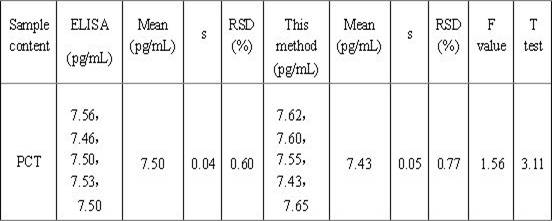Preparation method and application of electrochemical luminescence sensor based on silver vanadate/indium vanadate
A technology of silver vanadate and indium vanadate, which is applied in the fields of chemiluminescence/bioluminescence, electrochemical variables of materials, and analysis through chemical reactions of materials, which can solve the problems of high toxicity and difficult immobilization on the surface of electrodes, etc.
- Summary
- Abstract
- Description
- Claims
- Application Information
AI Technical Summary
Problems solved by technology
Method used
Image
Examples
Embodiment 1 4
[0038] The preparation of embodiment 1 tetraphenylethylene nano-cluster
[0039] (1) Preparation of silver vanadate / indium vanadate composite nanomaterials
[0040] Add 1.0 mmol of ammonium metavanadate to 60 mL of deionized water, and obtain a homogeneous solution under magnetic stirring. Subsequently, 1.0 mmol of silver nitrate was added to the above solution, and stirred under magnetic force for 20 min. The pH value of this mixed solution was adjusted to 8.0 using ammonia monohydrate with a mass concentration of 28%. The obtained mixture was transferred to a 100 mL Teflon-lined stainless steel autoclave and stored at 180 °C for 12 h. Afterwards, the resulting yellow sediment was collected by filtration and washed three times with deionized water. Finally, the product silver vanadate was obtained by vacuum drying at 60 °C. Next, 100 mg of silver vanadate was dispersed in 70 mL of deionized water and sonicated for 30 min, then 40 mg of indium nitrate monohydrate was added...
Embodiment 2
[0045] Example 2 Preparation of copper oxide-labeled procalcitonin detection antibody solution
[0046] (1) Preparation of copper oxide nanospheres
[0047] Mix 40 mL of 0.04 M copper acetate solution with 10 mL of 0.02 M 2,5-dimethoxyaniline solution under stirring until the mixture turns dark green. The mixture was then transferred to a 100 mL Teflon-lined stainless steel autoclave and heated at 180 °C for 2 h. The prepared material was washed with ethanol and dried at room temperature. Thus, cuprous oxide nanospheres with a special three-dimensional hierarchical structure were synthesized. Place the obtained powder in a muffle furnace at 500 °C for 3 h to obtain copper oxide nanospheres;
[0048] (2) Preparation of CuO nanosphere capture antibody incubation solution
[0049] Disperse the product obtained in step (1) into 5 mL of ethanol to form a stable dispersion, add 3-aminopropyltriethoxysilane, reflux at 100 °C for 1 h, and then vacuum-dry at 35 °C Dry in the oven ...
Embodiment 3
[0050] Example 3 Preparation of copper oxide-labeled procalcitonin detection antibody solution
[0051] (1) Preparation of copper oxide nanospheres
[0052] Mix 50 mL of 0.04 M copper acetate solution with 20 mL of 0.02 M 2,5-dimethoxyaniline solution under stirring until the mixture turns dark green. The mixture was then transferred to a 100 mL Teflon-lined stainless steel autoclave and heated at 150 °C for 2 h. The prepared material was washed with ethanol and dried at room temperature. Thus, cuprous oxide nanospheres with a special three-dimensional hierarchical structure were synthesized. Place the obtained powder in a muffle furnace at 500 °C for 3 h to obtain copper oxide nanospheres;
[0053] (2) Preparation of CuO nanosphere capture antibody incubation solution
[0054] Disperse the product obtained in step (1) into 20 mL of ethanol to form a stable dispersion, add 3-aminopropyltriethoxysilane, reflux at 150 °C for 3.5 h, and then vacuum-dry at 35 °C Dry in the ov...
PUM
 Login to View More
Login to View More Abstract
Description
Claims
Application Information
 Login to View More
Login to View More - R&D
- Intellectual Property
- Life Sciences
- Materials
- Tech Scout
- Unparalleled Data Quality
- Higher Quality Content
- 60% Fewer Hallucinations
Browse by: Latest US Patents, China's latest patents, Technical Efficacy Thesaurus, Application Domain, Technology Topic, Popular Technical Reports.
© 2025 PatSnap. All rights reserved.Legal|Privacy policy|Modern Slavery Act Transparency Statement|Sitemap|About US| Contact US: help@patsnap.com

